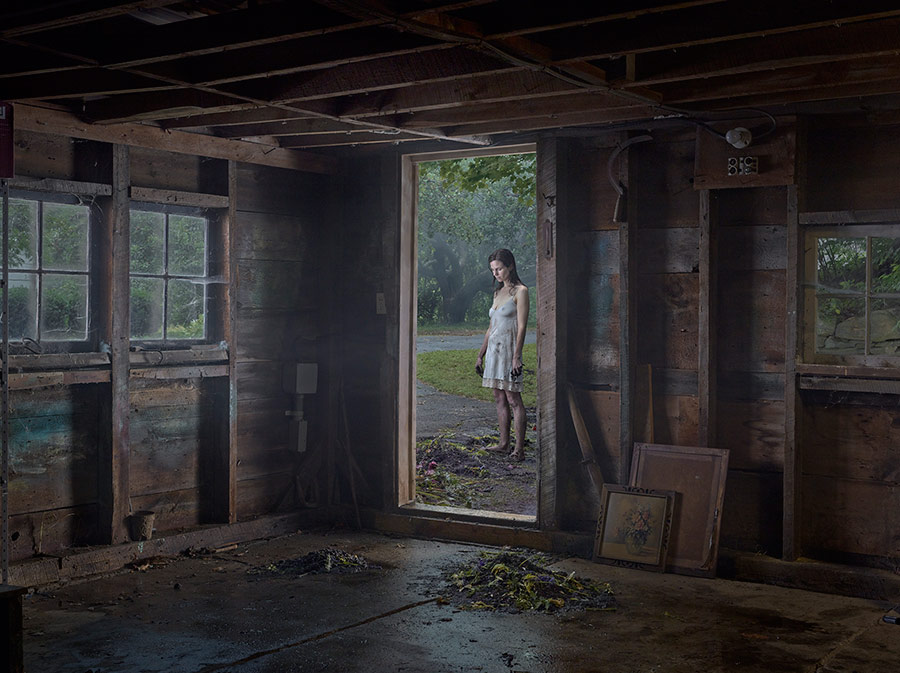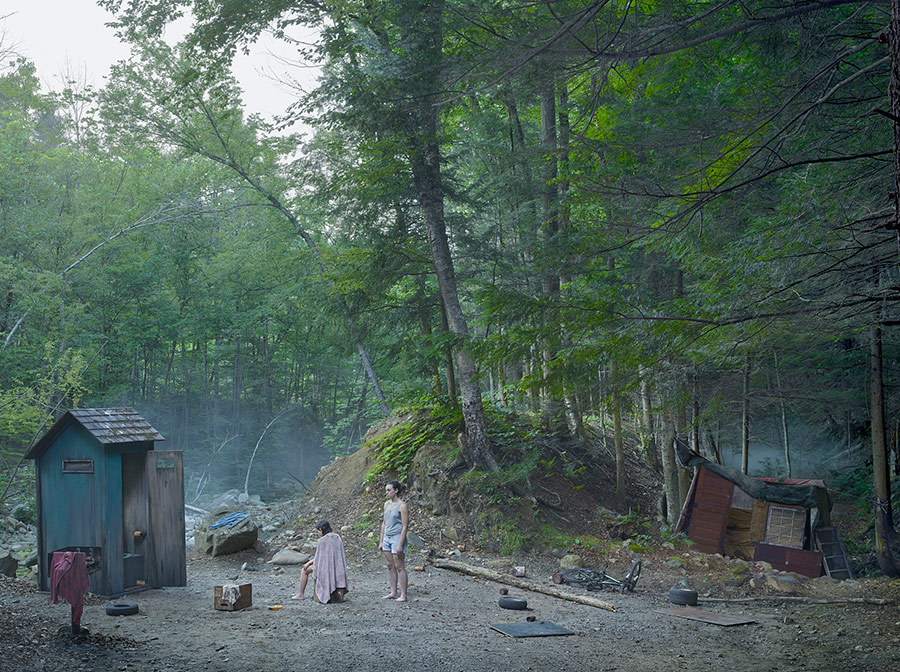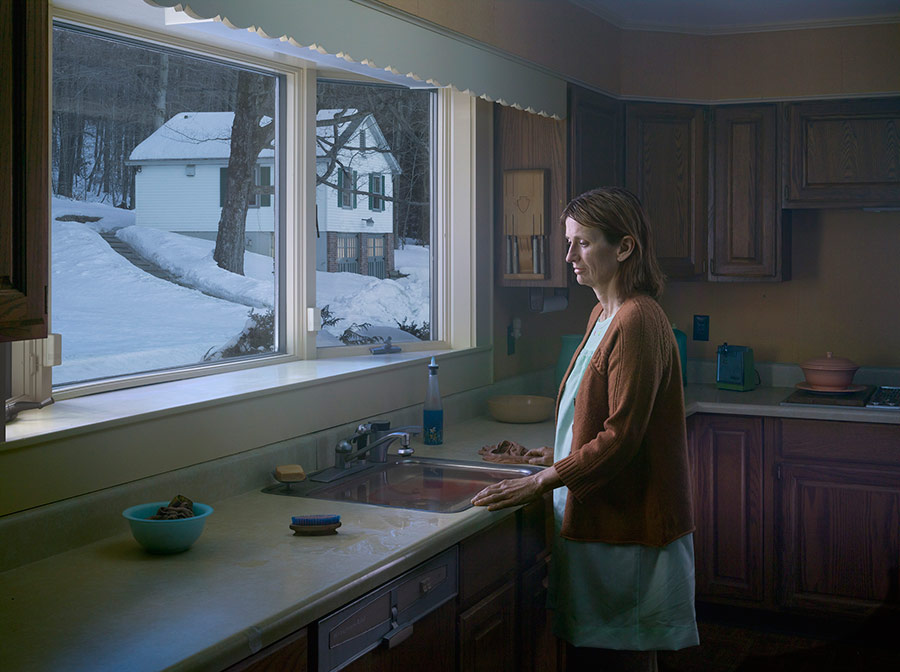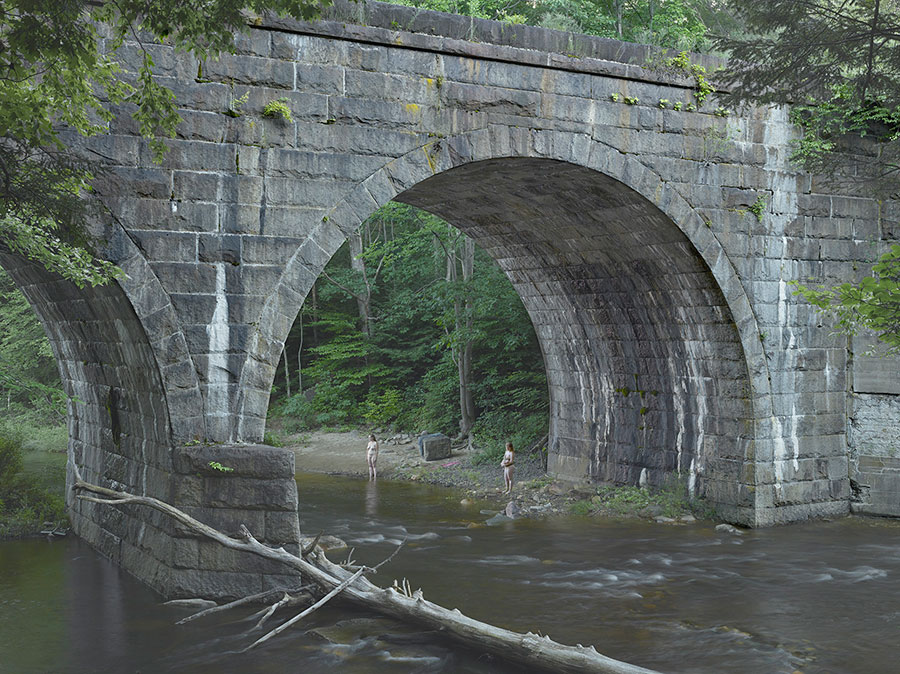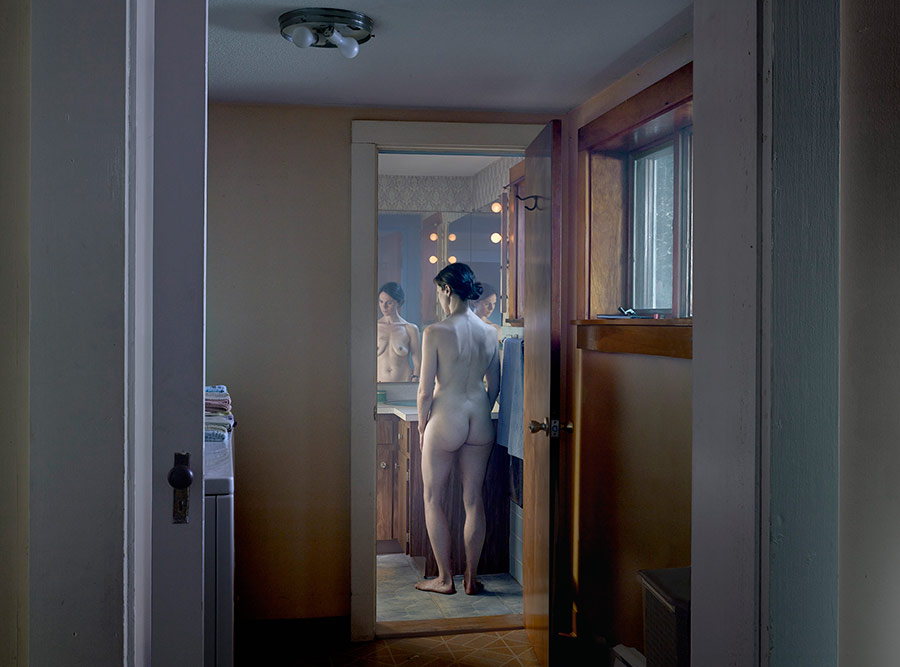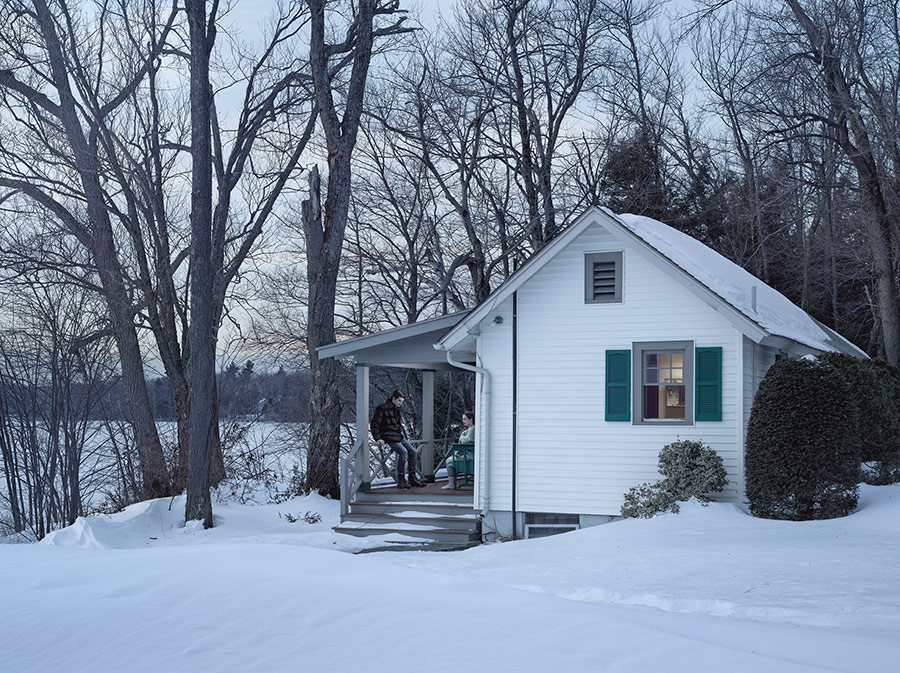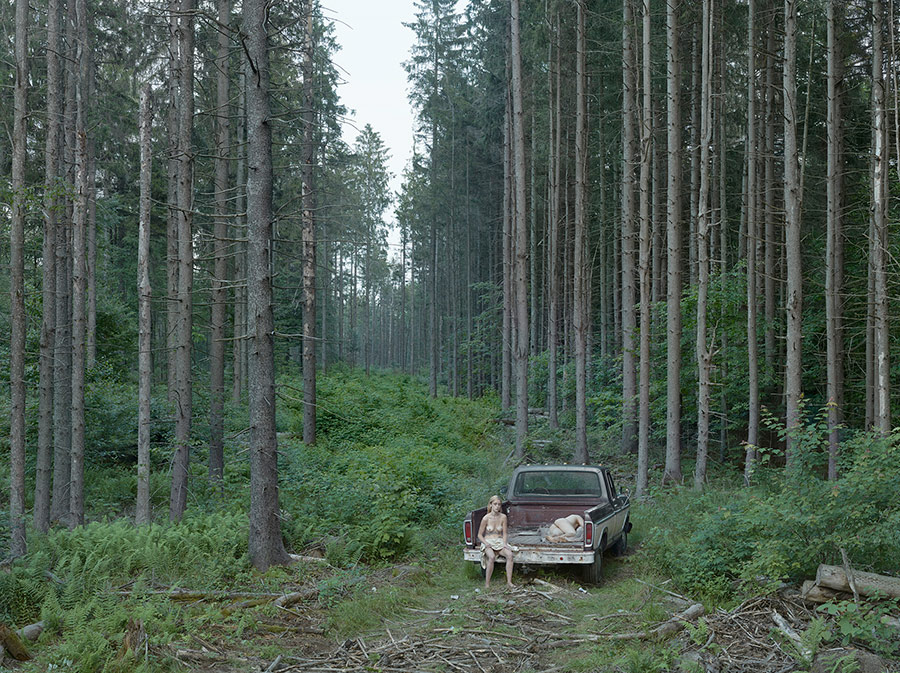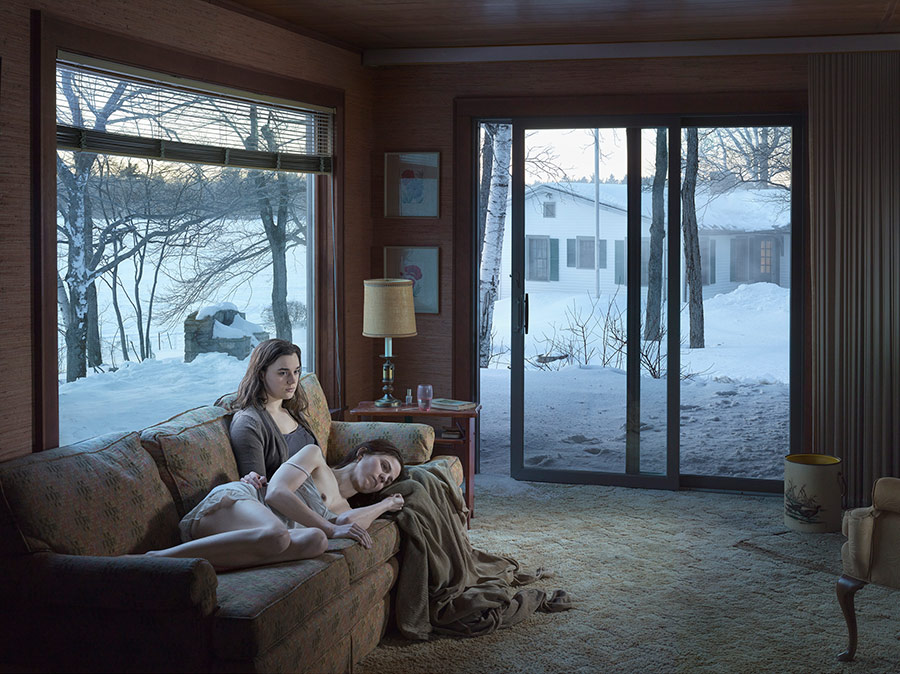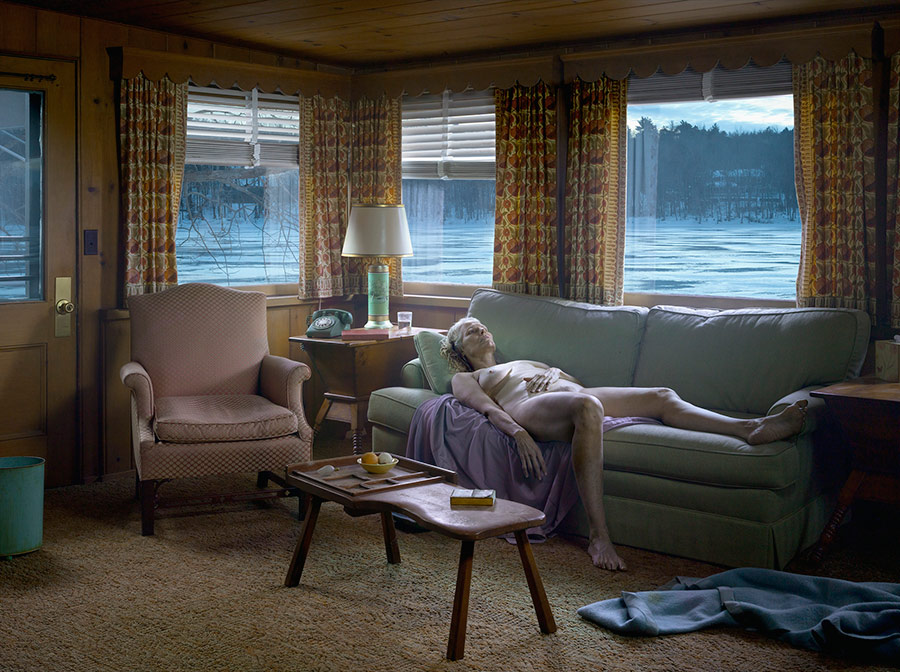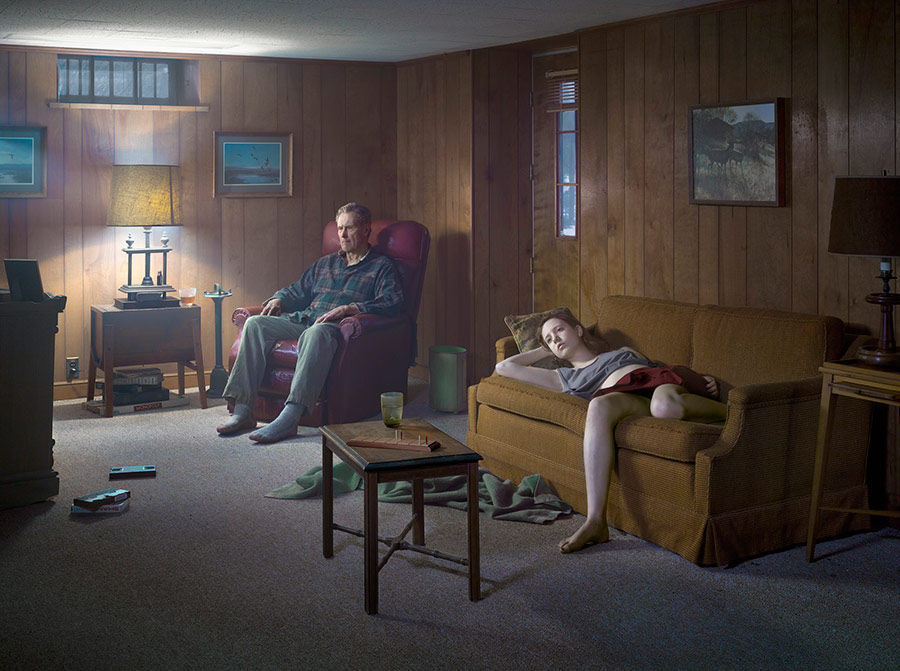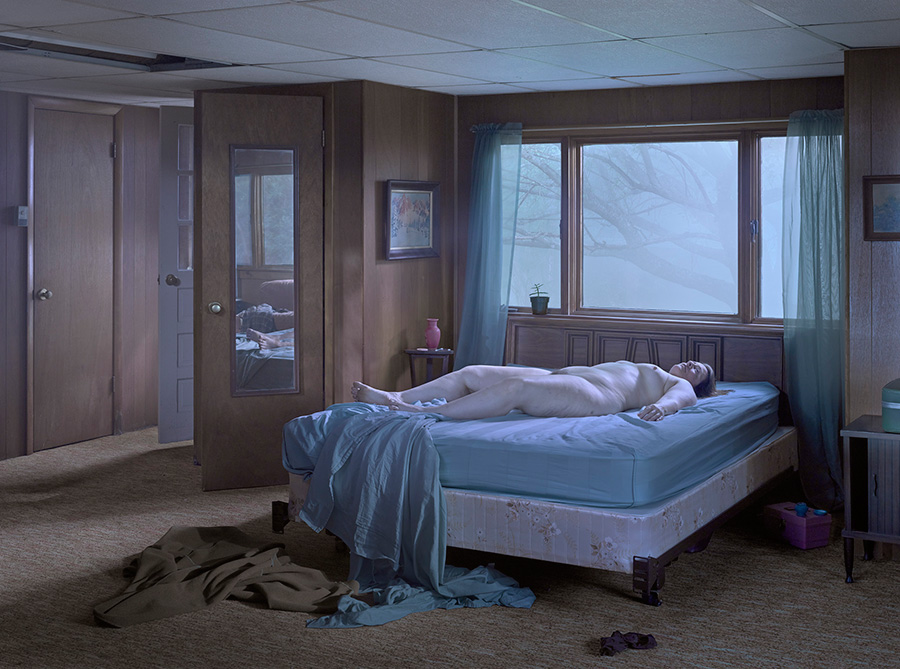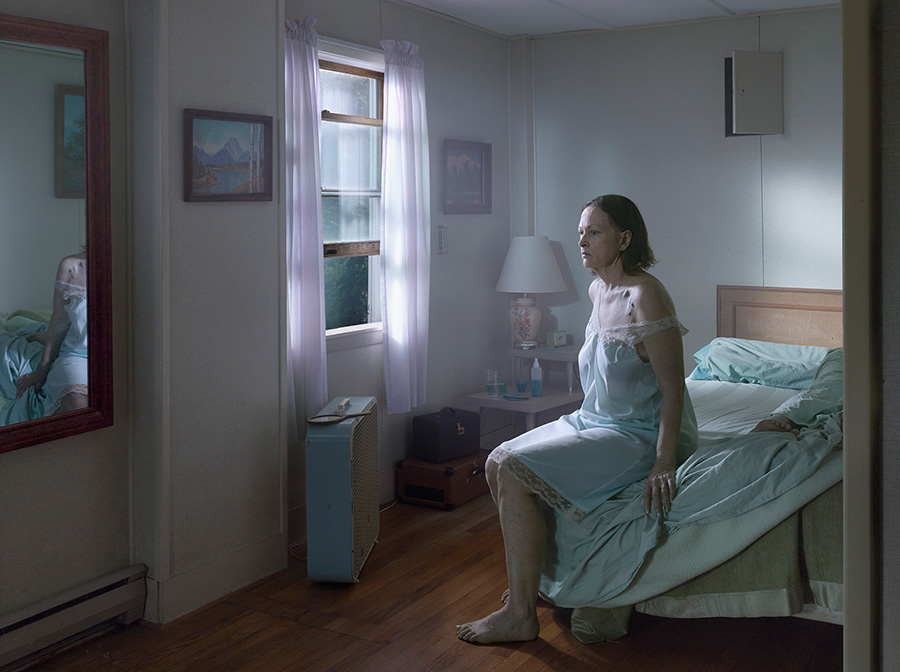Ken Weingart interviews Gregory Crewdson
Today, I am sharing an interview that photographer and blogger, Ken Weingart, conducted with photographer Gregory Crewdson. Ken has been producing interviews for his Art and Photography blog and he has kindly offered to share his interviews with the LENSCRATCH audience. Gregory Crewdson is one of the best known and influential fine art photographers working today. He is currently the director of the photography department at Yale University where he received his MFA. His work is internationally recognized as singularly unique for the painstaking lighting technique which he creates with the help of very large photo crews. His most recent series is titled Cathedral of the Pines, which was recently exhibited at the Gagosian Gallery in New York City. All images © Gregory Crewdson courtesy of the Gagosian Gallery.
When did you think of becoming a photographer?
I think my earliest memory of photographs came when my father brought me to the Museum of Modern Art when I was ten years old to see the Diane Arbus retrospective. I remember precisely that was the first sense I had that photographs could have psychological urgency and power. That was my first understanding of the mystery and complexity of pictures.
But it wasn’t until later in life that I became a practicing photographer. I took my first photo class at SUNY Purchase when I was an undergraduate. It came out of the frustrations with general academics because I’m dyslexic, and I’ve always had a hard time reading, writing, and test taking.
Originally, I wanted to study psychology and follow the path of my father, but I had a crush on a girl who was photography major. I ended up taking a photography class taught by Laurie Simmons. It was there that I took my first pictures, and I fell in love with photography. I think it was the stillness and the static nature of photographs, which appealed to me because, as I said earlier, I have problems with my linear thoughts. So it made perfect sense for me.
Before Yale, were you creating your own portfolio?
Yes. I had this weird three way major at SUNY Purchase that was photography, film studies, and American literature. It was like a liberal arts education. I went to Yale about a year after I graduated from the SUNY Purchase photography department.
Was Yale the same as it is now, and how did the experience there help you achieve where you are today?
It was much different then. I’m the director now, but the structure of the program remains the same. When I was there, it was much more geared towards a traditional understanding of the medium. It still has those values, but I think we’ve opened up quite dramatically. I don’t know if graduate school necessarily helps you. It’s by design that you are pushed to the limit. It’s a very demanding program. If anything, it helped me defend my particular position. I think that’s what graduate school is meant to do as you are coming of age as a photographer. Every artist comes of age, and when you come of age in the early 20s, you’re sort of set with the issues and consents for the rest of your life. You don’t really change much from that moment on. You can re-invent yourself in small degrees.
You have said that each artist has one story to tell. But aren’t there musicians, painters, photographers, etc, who reinvent themselves and do something totally different — or you don’t buy that?
When I say artists have one story to tell, I don’t mean that necessarily it will always look the same. What I mean is that the story is told through their work, and that is where you can see the obsessions. You can see the fears, the desires, the cornerstones of your story, yet it could change dramatically in terms of its appearance. If you follow any artist development over time, of many fields, I would argue that the core story remains the same.
Your story themes — can you put them in a word or two? Is it loneliness or isolation?
If I knew exactly what that story was, I wouldn’t have to make the pictures. I do feel that part of the story, or part of the central tenor of that story, is a search for connection or a search for home, a search for some kind of connection outside of yourself — some sensible sense of order. Photography is a lonely endeavor, and I think all photographers are in one way or another drawn to the medium by kind of an alienated viewpoint. Just the act of looking through a lens, a view- finder, is an act of separation. It’s an attempt to try to find the connection outside of yourself.
Cathedral of the Pines was based on places your father showed you. How did the idea come about? Did you cast through an agency or online?
There was a long period between Sanctuaries, my last body of work, and Cathedral of the Pines —mostly because I went through a very difficult period in my life. I went through a difficult divorce. I have two children; I moved out of New York, and into a church in Massachusetts. I was going through a period of dislocation and hardship. I started taking long walks up the Appalachian Trail, and doing long swims.
You might know that I’m an open water swimmer and cross-country skier during the winter. This was all a way to try to reconnect myself to nature. And, I was making all the pictures in Becket, where my family used to have a house. And one winter, I was cross country skiing in a pine forest. And there’s a little sign that said, Cathedral of the Pines. That was the moment that the idea came to me.
And this was an enjoyable, creative endeavor?
Well, I would never call it enjoyable, that is not the word I would ever use. The shoots were challenging. We work like a movie crew, and the conditions were difficult. We were working on a small budget, and under adverse conditions, and all those struggles made it all the better. You feel alive. But that’s not necessarily enjoyable. When you feel alive, you feel challenged, you feel creative. But it’s a lot easier not to work than to work. When you’re not making pictures, you’re not being challenged. So it comes down to that really.
You have said that if you are not working you feel like a fraud.
Well yes. You’re known as an artist and a teacher, and that’s what you do. So when you’re not doing what you preach, that’s fraudulent. As for the subjects, all people are from the area. I work very closely with Juliane, who I think you’ve met with. She’s in a lot of the pictures. She is my studio manager and the creative director. She’s also my partner and muse.
How did you evolve into shooting with such cinematic lighting and big crews? It’s unusual for a fine art photographer to have a full film crew.
I work very closely with a DP, a director of photography. We’ve worked together for many years. If there’s one characteristic that separates my work from other artists, it is the light. And to me it’s the most important thing about the entire enterprise — the light. It’s how you tell the story in photography, through light. We started working more dramatically in this way with the Twilight series.
You use all continuous light? And was it difficult to get the budget together?
It’s all continuous light, and it’s very elaborately staged. One of our hallmarks is having big lights in lifts, like daylight. Yes, it was hard, but you know what? The thing that people just don’t quite ever completely understand is that the process started off very organically. It started off slowly, and the small group became a larger group. Then slowly but surely, we put together a team over the years, and suddenly you’re working with a crew. For me, this is the way I know how to make pictures.
Do you miss smaller, intimate shoots from the old days?
Cathedral of the the Pines in relative standards, is much smaller than anything we’ve ever done — like with Beneath the Roses. We had a very small group, because I wanted the pictures to feel intimate.
Yet being so conversant with big crews you never thought of directing feature films?
Well, actually it’s always been an ongoing question. We’re in discussions right now in terms of the possibility of making a movie — a Hollywood film. It might happen. It might not happen. So it would have to be absolutely the right circumstance for it to happen.
But you once said you could not direct, it’s not what you do.
I think like a photographer. I think in terms of still images. So if I do make a movie, it wouldn’t look like any other. It would have a more urgent feel than other films because it would be from a point of view of a still photographer.
So you are looking at scripts?
We get scripts all the time. Juliane and I have been working on a script. She’s the writer, and I take notes.
Have you pursued much editorial or advertising photography?
No. It doesn’t really interest me. I’ve done a few things, rare exceptions. But I feel like I’m an artist foremost, and if you use your sensibility to sell something, then it’s no longer yours really.
It’s an assignment. Some people don’t know the difference.
Yes.
You mostly shoot in Massachusetts. Do you ever think of doing something urban, somewhere very different like in New York City or China?
No, I think certain artists have certain areas, or a place they respond to, that they like to work and that’s the case with me.
Who are some of your favorite photographers, past or present? I think Diane Arbus is in there?
Arbus, for sure, Eggleston, Walker Evans. My son is named Walker after Walker Evans. Cindy Sherman, of course. Those are some of my favorites.
You used to shoot 8 x 10 for many years, and now you are shooting digitally. What’s your system now, and do you miss 8 x 10, or do you feel liberated?
Yes. I used to have this expression, because I’ve worked with 8x 10 for so long in my life, that you live and die by the 8 x10. It’s such a limited camera, but it also has such clarity and beautiful description. Yet it’s a beast — it’s cumbersome and has limited focus. I can honestly say that when I was finished with Beneath the Roses, I was finished with the 8 x 10. I don’t miss it in any way, and I can’t imagine ever going back to it. But that doesn’t mean I regret using it. I loved it. Now I shoot with a Phase One camera, but it’s set up like a view camera.
How is the quality in your prints?
It’s even better. Just in terms of ease, and being able to see what you’re shooting. One of the great drawbacks shooting 8 x 10 is you can’t see what you’re looking at. One of the great paradoxes in doing this enormous production is that you are blind as to what is going on with the images.
With the Epson paper you use, is there a type you prefer, luster or matt, and do you usually have white borders?
Epson sponsored my last series, and gave me a brand new printer with paper. The paper I use is paper that was not on the market but I think it is now. It’s not my field of expertise, so I’ll have to ask my printer what the name of the paper is. I like luster. For Cathedral of the Pines, we just thought it would be nice to have a white border.
Do you sign your prints on the front, or the back, or not at all?
The picture is mounted and framed, and then the signature is on a sticker that’s part of the frame.
And you do editions of five?
Three.
And you have a framer?
Yes. Mark Elliot, who’s in Boston.
And Gagosian is your main gallery?
Gagosian is my main gallery. I work directly with them. I love it. It’s very big gallery and we’ve had a really good working relationship thus far. Then as the show sort of opens to different countries, and we will work with other galleries as well.
Do you have anything to say to artist about the gallery world?
I think the most important thing is to understand that no matter what or where you get, you will continually have to fight — nothing will ever come easy. And you will always have to push forward and make space for yourself in the world.
Are there any crazy or wild artistic projects you have not done that you want to do?
No, I feel like I’m very lucky that I’m able to achieve exactly what I want to achieve. With Cathedral of the Pines, I feel like for the first time I couldn’t have made the pictures any better than I did. It was very satisfactory.
In the past you felt like you could have done better?
Yes, it’s natural, but for this show, partially because I was absent from the art world for five years, it’s had an overwhelmingly great reaction. And I feel like I’m completely satisfied on some deep level. Especially since I isolated myself for years.
Do you enjoy teaching at Yale in New Haven?
I’ve been teaching for a long time, and for me, it’s very valuable to teach. And it’s always important to feel connected to the next generation of artists who are coming up. You learn as much as you teach. I approach it as an artist, and less as an academic.
So it’s helped your art?
Yes, for sure.
Do you think about your work enduring or being remembered after you’re gone?
Well, absolutely. I mean that’s your legacy, that’s what your left with, and especially in this age of Instagram, and pictures on cell phones, and social media; it’s a real challenge to think of the photograph still meaning something important.
Posts on Lenscratch may not be reproduced without the permission of the Lenscratch staff and the photographer.
Recommended
-
Salua Ares: Absense as FormNovember 29th, 2025
-
Ricardo Miguel Hernández: When the memory turns to dust and Beyond PainNovember 28th, 2025
-
Pamela Landau Connolly: Columbus DriveNovember 26th, 2025
-
KELIY ANDERSON-STALEY: Wilderness No longer at the Edge of ThingsNovember 19th, 2025
-
Jackie Mulder: Thought TrailsNovember 18th, 2025

